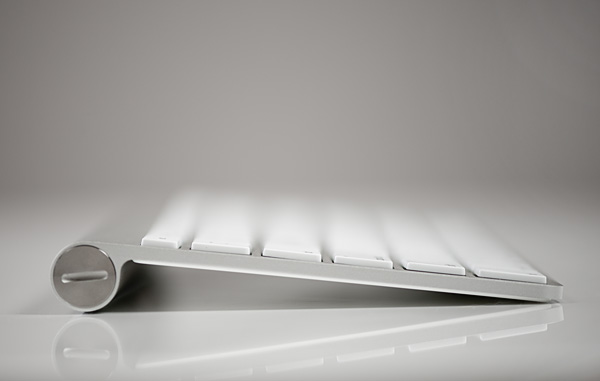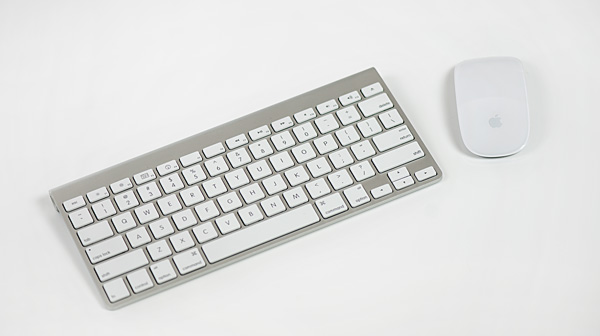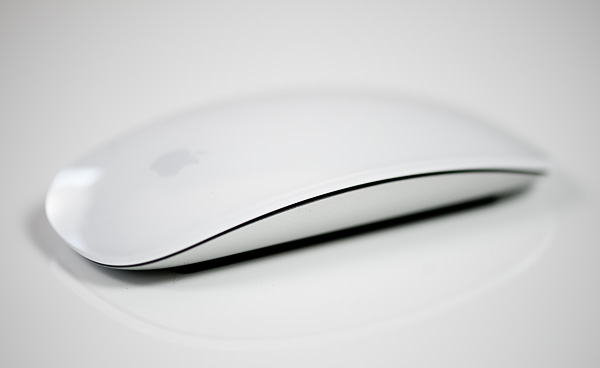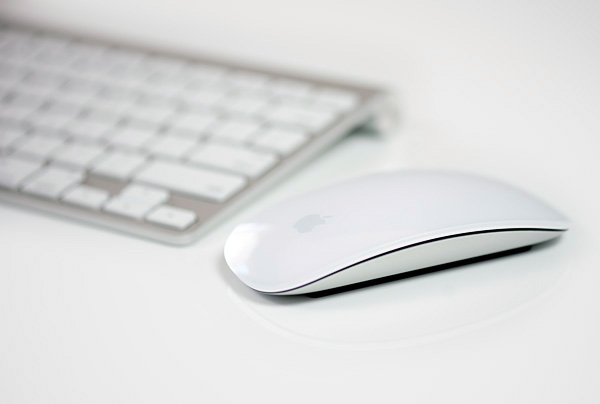The 27-inch Apple iMac Review (2011)
by Anand Lal Shimpi on May 27, 2011 2:30 AM ESTThe Peripherals
I've never been a fan of wireless peripherals - I didn't want more things to charge. Last year I finally broke down and bought a wireless mouse: Microsoft's Wireless Mobile Mouse 4000. I didn't buy it for mobility, I just liked the form factor.
The iMac comes with all wireless peripherals. In fact, if you stick with WiFi for network access, there's only a single cable you need going to the iMac: power. By default you get Apple's Wireless Keyboard and a Magic Mouse.
The Wireless Keyboard is a Bluetooth keyboard that runs off of two AA batteries. It pairs effortlessly with the iMac and I didn't encounter any issues with interference in using it. The keyboard seems to burn through batteries quicker than the mouse, perhaps that's because I type far too much or there's an issue with power management under OS X. After a week of use I'm down to 81% on a fresh pair of batteries (this is my second set).
The keyboard itself is a lot like Apple's standard aluminum keyboard, just wireless and more compact. Apple chopped off the dedicated home/end key island as well as the numeric keypad. Under OS X Cmd + Left/Right Arrow take the place of Home/End for me so part of the sacrifice isn't a problem, but the missing numeric keypad is. I do entirely too much data entry (ahem, benchmarks) to not have a dedicated numeric keypad, and for some reason Apple doesn't offer the Wireless Keyboard with one.
If you don't type tons of numbers every day however, the Wireless Keyboard is really nice. Apple had to stick a function key to the left of the control key, which is a bit bothersome (leave my control/option/cmd row alone) but it's nothing you can't get used to. The footprint is great. I have a giant desk, but I always seem to run out of desk space. The Wireless Keyboard makes it so that I can reclaim a small amount of high value desk area.
Typing feel and keyboard angle are both great - no complaints there. I'm a fan of Apple's keyboards.
Pointing devices designed in Cupertino are another story entirely. I've never liked Apple's mice. It was a big enough problem that when I first tried my Month with a Mac experience I ditched Apple's mouse. There was no way I was going to give the platform a fair shake if I had to use that thing. Since then Apple has at least enabled double clicking - the surface of the Magic Mouse is touch sensitive, click with your right finger and you get a right click. The Magic Mouse has no scroll wheel but drag your finger around on its surface and you get the best scrolling experience on a physical mouse.
The Magic Mouse is also a Bluetooth device that quickly pairs with the iMac. I noticed under Windows there's always a second or two of lag before it recognizes the mouse whereas it's useable as soon as you can see it under OS X.
My complaints about the Magic Mouse are three-fold. As I've mentioned before, the Magic Mouse doesn't have soft rubber feet that glide around on your desk. Instead you get two hard plastic strips that just seem to scrape against all surfaces. Tracking isn't a problem, but it's not a pleasant experience.
The other issue I have is the form factor itself. Microsoft's Wireless Mobile Mouse 4000 is small but it has a nice curve to it that seems to match my hand very well. The Magic Mouse on the other hand doesn't conform to any part of my body. I can lay my hand flat on it but either I'm not conditioned to do that or that's not a very comfortable way to use the mouse for long periods of a time.
Finally there's the clicking noise it makes. Modern mice seem to have a solid but more muted click, whereas the sharp click of the Magic Mouse reminds me of the past decade of Apple mice. I assume that's what Apple was going for, but Apple's market share has grown considerably in the past 10 years - it's ok to let go of some traditions.
Apple does offer the Magic Trackpad as a no-cost option. I have a love/hate relationship with the Magic Trackpad as a pointing device. Scrolling and gestures are great on it, but I prefer a normal mouse for most everything else.
















139 Comments
View All Comments
utlragear - Monday, June 11, 2012 - link
And here's the thing. It shouldn't cost any more than the difference for the monitors. But iPeople usually can't comprehend that.khimera2000 - Monday, May 30, 2011 - link
No 2000$ is not a big deal, and those people that are complaining are the ones that actually want the most out of there money.Sorry man hard as it is for me to brake it to you, especially since you have to hear it hear... but nerds know how to shop for computer parts, and they know whats it worth.
If you want to buy a 2000$ rig only to throw it away two years later and buy another 2000 rig go ahead.
I will take that same cash, keep the moniter and have 2000$ to spend on my next computer. where as you will have 1000$
i dont know about you, but I baught a really good moniter when i rebuilt my computer last, and am looking forward to spending that 1k that you will have to spend on a moniter on other cool tech :D
O ya im also looking forward to the following...
Upgrading my CPU, GPU, HDD, all me RAM, My Motherboard, and if a deal comes around adding two more moniters :)
Then again where all broken nerds right? and the above dosent really matter in your world.
You are right on them not targeting us though. We care about how long the life of our PC will be, what softwear goes into it, and the quality of the componants, where as a mac can be baought off the shelf by any shmuck off the streat.
Don't beleave me? then you are what Mac is targeting. For everyone else they understand what im talking about. Especialy the part where we research every peace that goes into our rig.
rubaiyat - Wednesday, September 7, 2011 - link
I've seen plenty of PC users blow much more than $2000 on their computers, WITHOUT a display. They tend to do it in bits and pieces and never add up the total cost because maths (and spelling) are not their strong points.They also have big trouble with equivalency. Perpetually claiming something quite inferior is equal to something distinctly superior, either through ignorance (never seen better) or price-tag fixation.
I bought my iMac 27" for about $1540. I didn't dumbly pay retail for it any more than you claim you do on your PC parts. No wasting massive amounts of time hunting down parts in magazines, dodgy PC fairs, eBay etc. hastling to fix the eternal problems, then sweating out the repairs because they have essentially no support.
My time can be better spent getting work done (not hanging out in rank dark rooms wasting the days away playing games). The iMac is beautifully svelte, fast, quiet and works out of the box. Not just a brilliant workstation but also a fantastic media station for after work.
You can't say I haven't shopped around. I did it for the iMac and got a very fast great deal in an afternoon. I know I got a bargain soon as I negotiated it and took. I had spent vastly more unproductive time going through the PC parts sites and shops, looking for the 'bargains' I could never find.
Just how do the higher prices you pay in these places, for sometimes cheaply made components, work out to be a "deal"?
utlragear - Monday, June 11, 2012 - link
mostly from broke nerds"? Is that why I have a 5500 square foot home paid for along with over 700k in savings? Keep in mind that some people don't buy apple because they were actually smart enough to understand it's mostly over rated, over priced, slow and outdated hardware out of the box. i7 based PC's came out a YEAR before apple even released them.Some people simply don't throw their money like water down a sewer as some college students do while trying to look hip, cool and pretend they are "rich" while they occupy an apartment. Another clue for you, people with lots of money that stay that way, usually aren't iSuckers. Do you know how many times I've heard that dumb, "People don't buy apple because they are broke bs?" Too many times. If you want to buy apple because the marketing is effective on apples credulous marketing demographic, then fine. But don't try to act like it's a great value because it isn't.
I'd rather buy my family 2 or 3 superior PC's with windows 7. And you are right. For MANY people $2000 isn't a big deal. But again, I don't believe that because that is true I should burn money to apple's delight. If I'm going to drop some cash it might be $15,000 for recording studio gear. Or a new car. Something you can't usually get a break on. .
Tros - Friday, May 27, 2011 - link
"Keeping your old monitor that is still good to save money makes sense but not on an all in one unit."Did you know that the 27-inch iMac works as a driven monitor? This is a new feature that I've yet to see on any other all-in-ones, esp. laptops, tablets, smartphones. The screens I could have saved on laptops, if they were able to be driven by a hardware solution.
Penti - Friday, May 27, 2011 - link
It's certainly useful when using it together with a MacBook Pro so you can connect it to your screen (iMac) at home or your workstation at work, and still use the built in workstation for other work. But it doesn't have use outside of that. It's not compatible with much else sadly (don't expect it to play nice with your video game console and so on). Neither is it independent from the on board motherboard.Neither is it a solution to save the screen. Which you can just get a new one three years later or so with your new iMac any way as Apple doesn't seem to be interested in release a Mac Medium stationary workstation with fast desktop parts. Sure a good external screen will last pretty well for 4-5 years and still be pretty high-end (if it doesn't break). But if your replacing your computer with a new iMac it's pretty pointless argument. If you run a MBP as workstation, a Mac Pro or a PC then you could argument for your external displays though, and the iMacs video in solution wouldn't be worth any thing just as a screen in those setups any way. Not when you can't tear out the motherboard.
KoolAidMan1 - Friday, May 27, 2011 - link
Mac Pros are too expensive for the vast majority of people, given the performance you're getting. I switched from PowerMacs to iMacs for my Final Cut Studio machine a few years ago and I'm never looking back. Cheaper, nearly as fast, and with a $1000 display built in.If a new model comes out, resale value is insanely high so you just ship off the old one and get a new iMac with faster components and an even better display. The move from the 24" iMac to the 27" iMac was one of the most economical upgrades I've ever made. I wish my PC upgrades were as simple and returned as much money.
Other plus is that it also works as a monitor for my gaming PC. Sadly that isn't an option anymore unless your computer has a Thunderbolt port, but that is my only real criticism of the 2011 models. If you don't intend on using it as a monitor as well as a Mac like I do, then it is really great.
Penti - Friday, May 27, 2011 - link
And just to clarify the 2011 iMac only works as a target display with 2011 MacBook Pro's, and prior to that you were limited to the mini-displayport input and what the monitor could do with that input. You could with the previous model connect a Mac Pro, MBP, MB, Mac Mini, PC or gaming PC with displayport and possibly consoles with an adaptor but not native. It's preferable if you can feed it with a 2560x1440 TDMS signal. (Computers can be connected with Dual-link DVI-to-DisplayPort adapter for like $200 USD too)So it's pretty useless today for use as input if you don't plan on a dual mac configuration with iMac 2011 and MBP 2011. No expensive adaptors that work with the Thunderbolt Mac yet too. Certainly not a great convenient solution for use of your screen with all your favorite electronics at least. That said, I wouldn't use the external 27" Cinema Display with Blu-ray players and consoles either. The previous solution with 2009 late and 2010 mid iMac 27" models wasn't good with gaming consoles and BD-players either it had to use and pass-through the 720p signal to your screen and didn't support 1080i or 1080p. The monitor/iMac didn't accept 1080p signals at all. Which meant you needed a separate $299 USD scalerbox for that. Or get by with 720p. Which basically meant you needed $500 US Dollars worth of hardware with the old model in order to connect a none DP PC/Mac Pro high-res and a BD-player and or console scaled to native res. They could do it better. But that would mean a separate driver/controller board for the monitor/panel.
headbox - Friday, May 27, 2011 - link
unlike your Alienware/PC hardware, you'll be able to sell the iMac for close to what you paid for it years later. I bought a Macbook Pro for $1800 and sold it TWO years later for $1500, and 50 people people called wanting to buy it. Try putting a 2 year old Dell online for sale- you won't get 50%, if at all.The0ne - Friday, May 27, 2011 - link
The fact is people buying Macs are NOT your conventional user, in the least. They will love it because it's sleek, it's compact thus saving space, and as far as the people I know that like them money is not a concern even if it is. Apple consumers are a strange lot, you either accept it or not.The example given by headbox is a prime example. Why would anyone pay close to the original paid price for a 2 year old Mac? It's not logical at all in any sense except to own a Mac yet people do it all the time. I can understand if there were benefits to this but there really aren't. It's just "I have a Mac" thingy.
But make no mistake though, if you are going to get one and keep it for a long time might as well get one with a nice big screen. I have 3 Dell 30"s that I saved up and bought and wouldn't go back to anything less. My eyes are grateful until I use my M17xR2. My eyes aren't that young anymore!